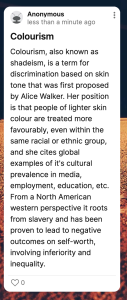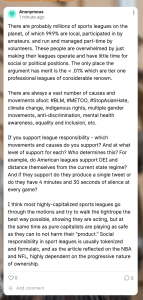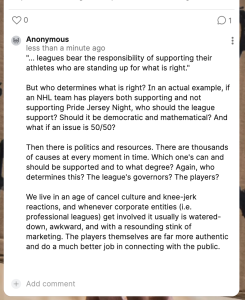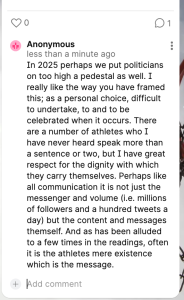3
Section One: The Fundamentals
A) Keywords
Exercise 1:
Briefly (in 100 words or less) define one of the keywords in the padlet (including one that you. may have added yourself).

|
B) Representing Race
Exercise 2: Notebook Prompt
In about 50-70 words, consider Joel Bervell’s question: why do we feel the need to extrapolate the athleticism of one Black athlete to all Black people when we do not do the same for white athletes?
Try to think of examples when this happens, making sure to reflect on your own positionality.
| Because of heuristics. Black athletes are disproportionately successful in athletics (Black women had almost half the USA women’s medals in Paris) and as opposed to cultural/academic investigations involving context, the easy mental conclusion is shortcutting it to genetics.
I disagree with Bervell about his examples. Phelps (and Thorpe) were seen as freaks of nature more than the result of coaching and determination, and Bolt was seen as similar, possessing the mechanics of a short-distance sprinter in a powerful 6’5″ frame.
|
C) Gender, Race & Sport
Exercise 3: Notebook Prompt
What are some strategies for resistance that Rajack and Joseph identify in their article as a means of pushing back against and resisting misogynoir?
| First and most obvious is resistance through self-representation, which is one of the three main themes of the paper. Athletes can use their celebrity and platform to have considerable impact on how they are perceived. A second strategy is attached at the hip to the first; the importance of informational and communications technologies (ICT’s) like blogs, social media, and websites, which can be employed by athletes and act as a hedge to traditional male-dominated media, forcing greater accountability. Third is detection and the use of Critical Discourse Analysis (CDA) as a tool for identifying instances of misogynoir and creating greater visibility.
|
Section Two: Making Connections
A) Athlete Activism
Exercise 3: Padlet Prompt
Do athletes have a responsibility to use their platform for social change? Why or why not? Please remember to record your response in both the padlet below and in your Notebook.
B) Athlete Activism & Feminism
Exercise 4: Complete the activities
Exercise 5: Notebook Prompt
What do the authors of the article call for as a way of challenging how mainstream sports journalism privileges neoliberal feminist concerns? (100 words max.)
| Cooky and Antunovic propose a change to how we study and talk about sports media by using a more inclusive approach focusing on all ICT’s including new media. This departure from the limited established patriarchal sports reporting allows for different voices and stories which “inform and are informed by feminisms.”
NOTE:
|
C) Corporate social justice
Exercise 6: Padlet Poll
 
(1) I wasn’t sure where to add the response to the section on “Intersections: Sport, Immigration, and Religion,” so will add it here as a link: (2) Below is the response to “Taking a Shot”: The cinematic references are 42 (Jackie Robinson), The Express (Ernie Davis), Race (Jessie Owens), and Glory Road (Don Haskins). As Gailily asserts in “Shut up and dribble!,” sport is both a functionalist “apolitical space” while at the same time “does not operate in isolation from broader society.” These films speak to this dichotomy and the intersection of celebrity, athletics, and social justice. What strategies do athletes employ to speak out? What is the commentary on athletes using their voices in these shows? How do race and/or gender or other identities inform this representation? How do these representations shape how we understand the sports themselves? Reference:
|
Section Three: Taking a shot
Module Assignment (submit as part of notebook and separately through Blackboard mini assignment #1 portal)



